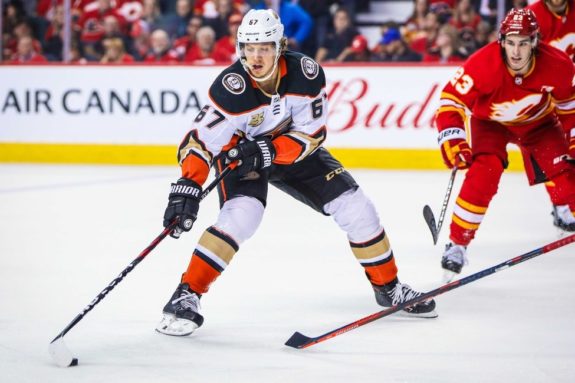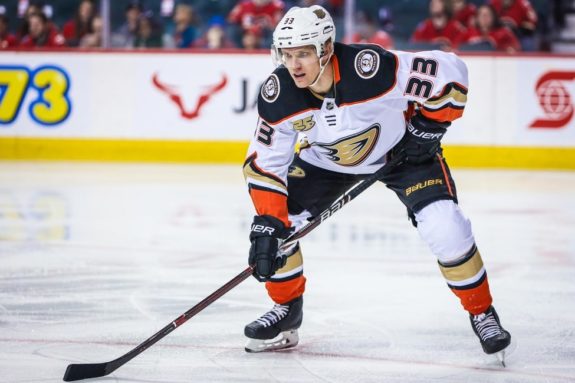The opening week of the NHL’s season is upon us and the Anaheim Ducks will drop the puck Thursday, Oct. 3 against the Arizona Coyotes. Though it’s a team sport, strong performances from an individual player can win a game for a team (not to mention your fantasy team). At the end of the season, those two points can be crucial in a playoff race. Jakob Silfverberg’s combined history against this week’s Ducks opponents, the Coyotes and the San Jose Sharks, plus his finish to last season and some developments in the preseason, Silfverberg will be this week’s Duck to watch.
Swede Line Ready for Prime Time
I’ve harped on it again and again in nearly every article I’ve written since May; the Ducks offense was abysmal last season. Due to in part to injury and lack of offensive depth, Anaheim didn’t use a single line combination more than 6.5 percent of the time in 2018-19. Even with that offensive dysfunction and a rotating cast of linemates, Silfverberg achieved his career-best in goals scored at 24.
If the preseason and the end of 2018-19 is any indication, Silfverberg is about to get a considerable boost. On multiple occasions in the preseason, head coach Dallas Eakins paired Silfverberg and Rickard Rakell together as top-line wings with both Sam Steel and Isac Lundestrom in between them.
Lundestrom, Rakell, and Silfverberg teamed up for a very nifty goal in the Ducks’ victory over the Sharks on Sept. 24.
Even if Lundestrom lands with the San Diego Gulls to start the season, and Steel can’t suit up for an extended period of time due to injury, Rakell and Silfverberg should be the wings on Anaheim’s top line.
Silfverberg Getting More Offensive
In an article written by The Orange County Register’s Elliot Teaford, Silfverberg highlighted his excitement to play with Rakell and the offensive potential it provides.
“I think I get more opportunities, and I think I get more power-play time, too,” Silfverberg said of his union with Rakell, in particular. “A lot of times we got matched against the other team’s top line (while with Cogliano and Kesler). I feel, definitely, I get more offensive opportunities.
“Playing with ‘Ricky’ I get put in that spot a lot more. ‘Ricky’ is offensively skilled, as well, so that helps, having a guy who’s offensive-minded and is always trying to score goals and on the hunt to score more. I think my mindset is more offense now, but I’m trying not to change too much.”
(from ‘Ducks forward Jakob Silfverberg eager to produce in expanded offensive role’ The Orange County Register – 9/30/19).
If you don’t trust the preseason, the end of the 2018-19 season provides more evidence. After the trade of Andrew Cogliano and Ryan Kesler’s injury broke up the shutdown line of Silfverberg, Cogliano and Kesler; Silfverberg joined Rakell and Steel and things took off.
Silfverberg notched six of his goals — one-quarter of his total 2018-19 output if you’re a math person — in the season’s final month. Three goals were even-strength assisted by Rakell and one was a power-play goal assisted by Rakell. He added five assists on Rakell’s goals in the same span. Four of them were at even strength and one was on the power play.
Silfverberg and Rakell Must Combine Forces
Thanks to the defensive success of his line with Kesler and Cogliano, Silfverberg hasn’t had much of an opportunity to develop even-strength chemistry with Rakell. Comparing the time they’ve spent together with other successful top-line combinations in the league, shows just how little Silfverberg and Rakell played together last season.

According to linecombinations.com, the Boston Bruins lethal grouping of Brad Marchand, Patrice Bergeron and David Pastrnak spent 13.6 percent of 2018-19 together at even strength compared to other Bruins line combinations.
The Colorado Avalanche’s dynamic trio of Mikko Rantanen, Gabriel Landeskog and Nathan MacKinnon played 22.7 percent of their team’s even-strength time together compared to other line combinations.
That number for Rakell and Silfverberg with anyone else on their line is just under seven percent.
As he mentioned in his quote in The Orange County Register, when he was teamed up with Cogliano and Kesler as the Ducks’ shutdown line, he took the ice to defend against his opponents’ best forwards. Even though the objective for any forward in hockey is to score, a third-line or checking-line role focuses as much on defense as it does offense. In a top-line role, Silfverberg and Rakell will be tasked with powering the Ducks’ offense, which means good things for his production.
Add that to the difference in coaching philosophy between former Ducks coach Randy Carlyle and new head coach Eakins, you have even more potential. Carlyle beat the “dump and chase” to death, much to the detriment of a skilled offensive player like Silfverberg playing a third-line role. Eakins encourages more offensive creativity creating a recipe for a strong start by Silfverberg.
Silfverberg Crushes West Coast Critters
If the potential of his chemistry with Rakell isn’t exciting enough, Silfverberg’s recent history with the Ducks first two opponents is even better. Last season, Silfverberg scored two goals and added three assists in five games versus the Coyotes. In 2017-18, he had two assists and a goal in four games against Arizona.

If Silfverberg killed the Coyotes in 2018-19, he made soup of the San Jose Sharks. Over five games, Silfverberg racked up seven points, (two goals and five assists). Finally, Silfverberg has a combined five points in the Ducks last three season-opening games.
If you’re looking for a Duck to keep your eye on, add to your fantasy team, or just sound like a psychic to your friends, that Duck is Silfverberg. His chemistry going back to the end of last season with Rakell, his success against the Sharks and Coyotes and his recent penchant for opening day production makes him a prime candidate to play well in the season’s opening week. If Dallas Eakins continues to keep Silfverberg paired with Rakell that success may last much longer.
All stats from hockey-reference.com